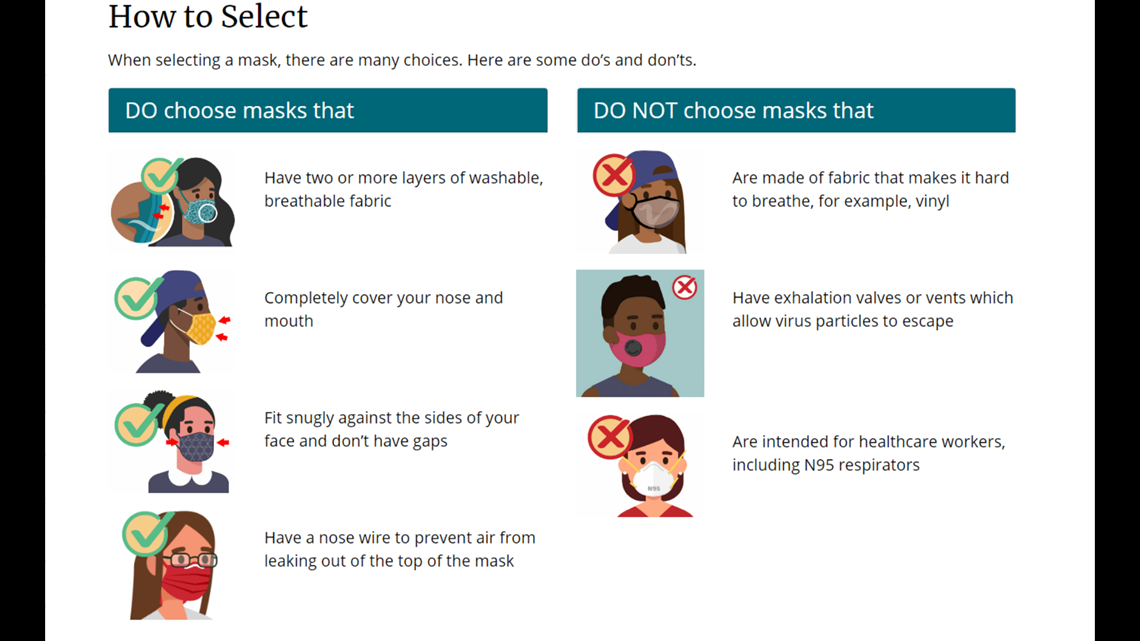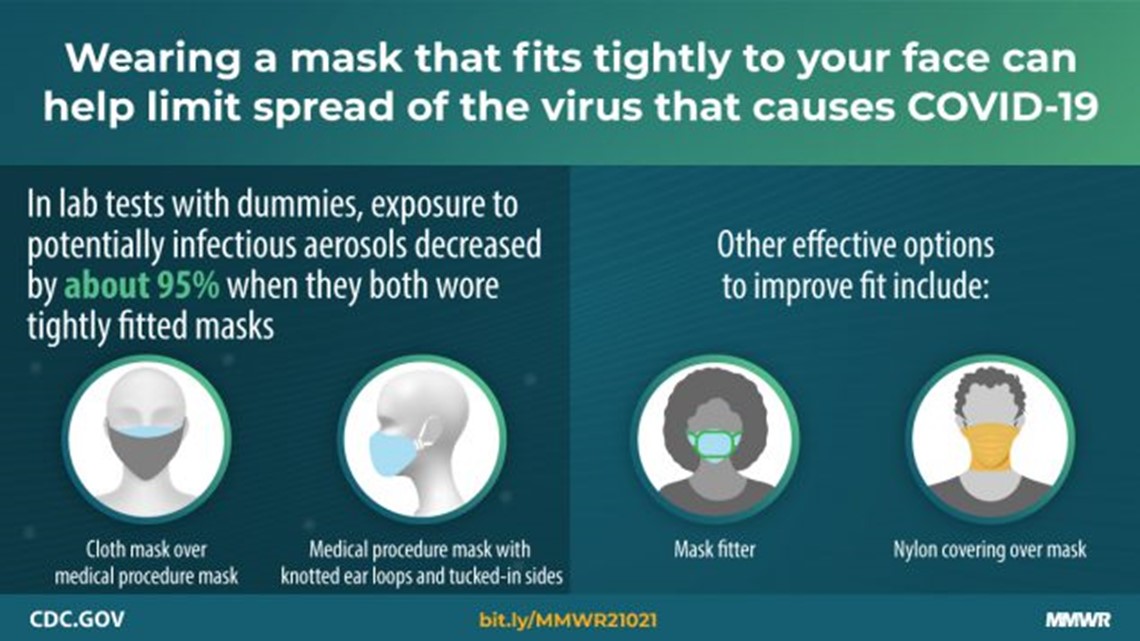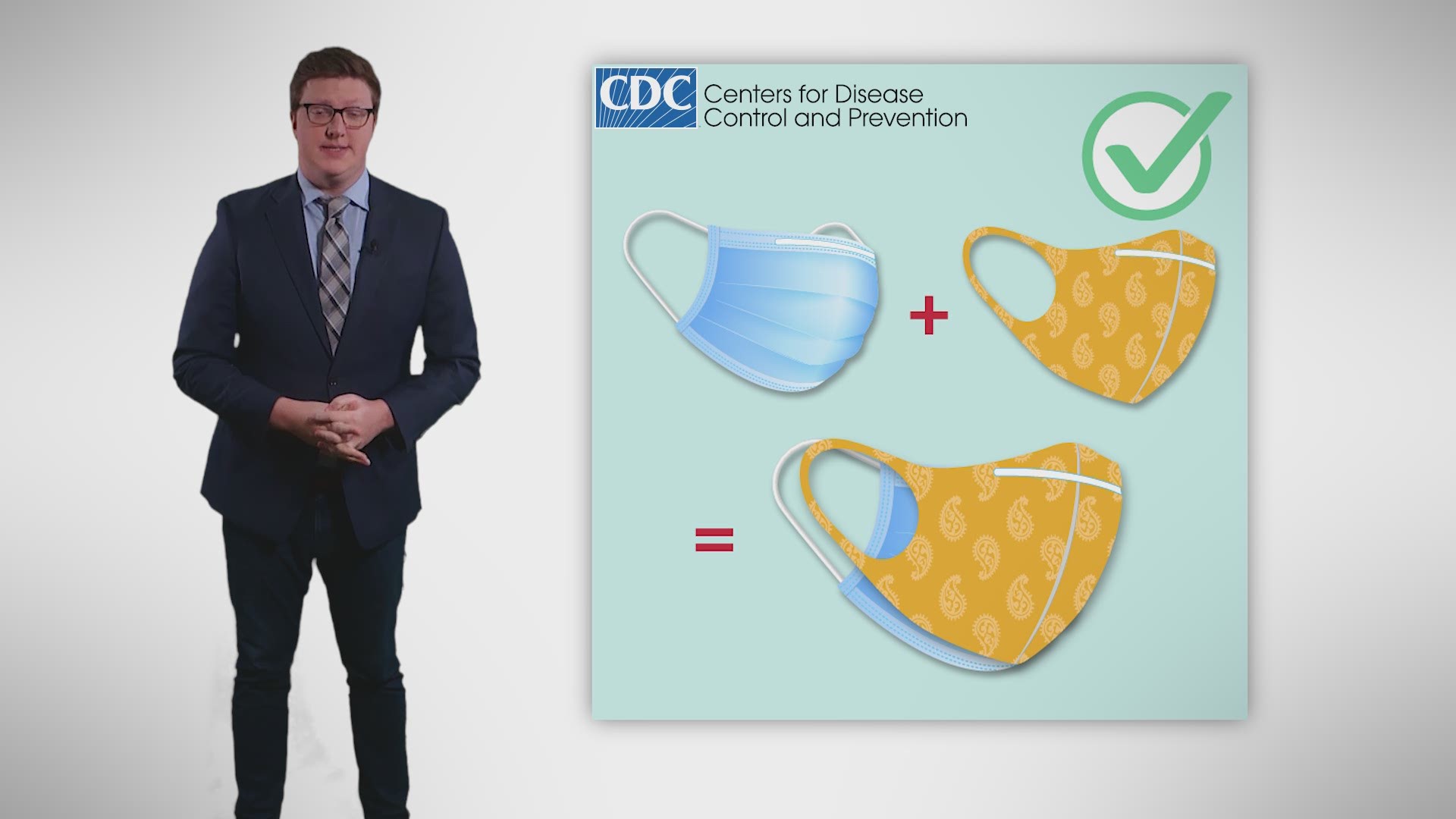WASHINGTON — QUESTION:
Which masks do the Centers for Disease Control and Prevention recommend you wear to protect yourself against COVID-19?
ANSWER:
The CDC recommends that the public wear face coverings with two or more breathable layers.
SOURCES:
- Dr. John Brooks- chief medical officer for the CDC's COVID-19 emergency response
- CDC website
- CDC/NIOSH study- "Efficacy of face masks, neck gaiters and face shields for reducing the expulsion of simulated cough-generated aerosols"
- CDC Morbidity and Mortality Weekly Report (MMWR)- "Maximizing Fit for Cloth and Medical Procedure Masks to Improve Performance and Reduce SARS-CoV-2 Transmission and Exposure, 2021"
PROCESS:
Local and national public health experts have been telling the public to "wear a mask" for months.
During a press conference back in November, Maryland Gov. Larry Hogan coined the phrase, "just wear the damn masks," which later became somewhat of a catchphrase.
But which ones should we be wearing, and what features should we be looking out for?
Our Verify researchers spoke with Dr. John Brooks, chief medical officer for the CDC's COVID-19 emergency response.
"People should get the mask that fits them well and that they're willing to wear, because any mask is better than no mask," Brooks said.
So first step, wear a mask.
But as the CDC's website explains not all masks are created equal.
What features should you look for in a mask?
According to the CDC, you're going to want a mask that has multiple layers, fits snugly, but that's also breathable and comfortable.
They recommend masks with:
- Two or more breathable layers
- Made of tightly-woven fabric
- Masks with inner filter pockets
- Covers your nose and mouth completely
- Doesn't gape around the sides of your face
- Has a nose wire to stop air from escaping
Brooks suggests finding a mask that achieves a good seal, since one size might not fit all. He recommends finding masks that have ties that go around your head instead of ear loops, or masks that have adjustable ear loops.
He also says if your medical mask starts to gap at the sides, you can knot the ear loops and tuck in the extra fabric to create a better seal.
Still, one solution might not work for everyone.
"People like me who have kind of a bigger face, that knotting reduces the size and it doesn't really cover my nose and mouth completely," Brooks said. "...the way you can test to see if it's working, well, put on some glasses make sure you're not fogging them, and then if you breathe in and out you'll see the fabric moving, which is a sign that you're pushing the air through and pulling it in through the fabric and not in and out of the side gaps."
What features should you avoid in a mask?
The agency says not to choose masks:
- Made from materials that are difficult to breathe through
- Include valves or vents
- Are intended for healthcare workers like N95 respirators
- Made of a single layer
- Made of a thin fabric that doesn't block light


Both gaiters and face shields have become the go-to masks for some, and the object of skepticism for others. Do they do a good job protecting you against getting sick?
The CDC says if you wear a gaiter, pick one with two layers or fold it so that you create two layers.
As for people seen wearing face shields without a mask, the CDC says face shields are not a mask substitute, writing that "goggles or other eye protection may be used in addition to a mask."
They source a research study that the CDC itself funded, which studied how well different masks shield cough particles.
They tested a medical-grade procedure mask, a three-ply cotton cloth mask, a polyester neck gaiter, an N95 respirator, and a disposable face shield, to see how many cough particles each mask blocked from collecting at the bottom of the vacuum. Essentially, how well does the mask shield others when you cough.
According to the study, here's the percentage of cough particles each mask blocked from releasing:
- Medical procedure mask- 59%
- Three-layered cotton mask- 51%
- Single-layered polyester gaiter- 47%
- Double-layered polyester gaiter- 60%
- N95 respirator- 99%
- Face-shield- 2%
The study notes that they only experimented with a single version of each type of mask: "We only used a single representative example of each type of device. The shape and composition of face coverings vary widely, and this would be expected to affect the performance of individual devices. Some face masks have exhalation valves or vents which could reduce their efficacy as source control devices. The fit of a particular mask to an individual wearer and compliance in wearing the mask correctly (i.e., over the nose and mouth) also are important factors in how well the mask performs as a source control device."
What do we know about "double masking?"
In early February 2021, the CDC released a report that indicated that "double masking," or wearing a medical mask under a cloth mask, could offer additional protection. It also found that knotting ear loops on medical masks had a similarly beneficial effect.
In a nutshell, experiments were conducted to see how a better-fitted mask reduced exposure between two individuals.
In lab tests with dummies, researchers found that if both double-masked, the risk of exposure to "potentially infectious aerosols" decreased by about 95%. In a separate study, researchers found the same was true if both individuals knotted their ear loops for a tighter fit.


Here's what the first experiment found in terms of blocking a cough from emitting:
- an unknotted medical mask blocked 56.1% of particles
- a cloth mask blocked 51.4% of particles
- Double masking blocked 85.4% of particles
- the knotted and tucked medical mask blocked 77% of particles
The second experiment looked at different combinations of who was wearing the double-mask or knotted and tucked medical mask during breathing.
Here's what the second experiment found:
- A double-masked source reduced exposure to an unmasked receiver by 82.2%
- A knotted-and-tucked-masked source reduced exposure to an unmasked receiver by 62.9%
- An unmasked source but double-masked receiver reduced exposure by 83%
- An unmasked source but knotted-and-tucked-masked received reduced exposure by 64.5%
- A double-masked source reduced exposure to a double-masked receiver by 96.4%
- A knotted-and-tucked-masked source reduced exposure to a knotted-and-tucked-masked receiver by 95.9%
Brooks was the lead scientist on that study and says it's not just about improving the fit of your mask but also getting the right combination.
He explains that medical masks, often made of polypropylene are really good at filtration, and cloth masks are good at contouring your face.
Wearing two medical masks wouldn't work because you'd still have that gaping issue, and wearing two cloth masks wouldn't offer the same medical mask filtration and could make it difficult to breathe.
If you wear a mask, does it protect others or yourself?
"The secret answer is it does both," Brooks said, "and that's why it works so well."
Brooks explained that during their lab experiments testing they used masks on both the "source" and the "receiver" to test in a lab how well masks blocked particles from expelling and how well masks blocked particles from entering.
"Now, when we took those masks that were modified, either the cloth over medical mask or the one that was knotted and tucked, when you put it on just the source or just the receiver, you got the same amount of reduction at the receiver end, about 60 to 80% reduction depending on which way you go," Brooks said. "But when you put them on both, the receiver's exposure was reduced by over 95%, and that speaks to this compounding effect you get when everybody's masked. It's stopping the virus from getting out, and then what gets out we prevent it from getting in."


